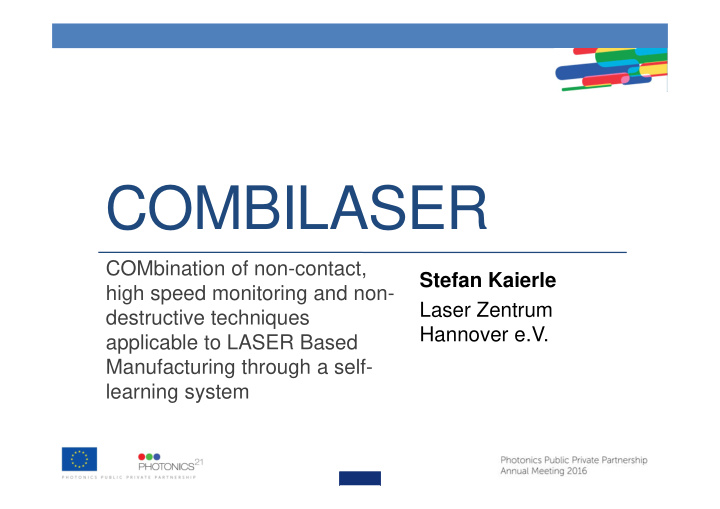



COMBILASER COMbination of non-contact, Stefan Kaierle high speed monitoring and non- Laser Zentrum destructive techniques Hannover e.V. applicable to LASER Based Manufacturing through a self- learning system
Fact sheet Partners: • HIDRIA AET (SLO, coordinator ) LE - automotive IK4 LORTEK (ESP) RTD LASER ZENTRUM HANNOVER (GER) RTD RESEARCH CENTER FOR NON DESTRUCTIVE TESTING (AUT) RTD UNIVERSITY OF SHEFFIELD (UK) RTD LASERLINE (GER) SME – laser supplier ORKLI (ESP) LE – domestic applicances TALLERES MECÁNICOS COMAS (ESP) SME – oil & gas industry MONDRAGON ASSEMBLY (FRA) SME - automation 4D (GER) SME – laser sensors CAVITAR (FIN) SME – illumination technology SIEVA (SLO) SME – automotive • Total costs: 3.439.420,00 EUR • Duration: 36 months (01.01.2015 – 31.12.2017)
Fact sheet • Main objective: To minimize defects appearing in laser based manufacturing to fulfil the zero-failure manufacturing approach • How to fulfill this approach? Combination of non-contact, high speed monitoring and non- destructive techniques and feed the generated and synchronized data through a self-learning system • Monitoring techniques: Laser ultrasonic Temperature profile monitoring Weld pool and spectral monitoring Monitoring of laser power and process speed
Fact sheet • Synchronization: Use of Position Synchronized Output (PSO) workpiece PSO weldseam defect • Feed the data to self lerning system • Integration into three different processes • Industrial demonstration and validation
Fact sheet • Main objective: The minimization of defects appearing in laser based manufacturing fulfilling the zero-failure manufacturing approach . For that purpose, the combination of these two worlds (monitoring data vs. detected defects by NDT) through a self-learning system (SLS) -human-centric system- will be developed • Sub-objectives: Productivity increase of about 35 % in gas valves repairing process due to required re- works reduction (cladding layer and base material cracking avoidance). • Allow to take to the market new generation of pressure sensor glow plug 45 % faster thanks to the avoidance of cracking appearance using the developed SLS. • Reduce time-to-market of new flame device sensors by at least 45 % thanks to acquired knowledge in previous products manufacturing thanks to SLS. • Reduction of scrap parts and wastes in new pressure sensors (for glow plugs) manufacturing processes of up to a 50 % through laser welding monitoring and process parameters control. • Decrease the number of flame sensor defective parts up to 75 % thanks to the continuous increase in LBW process knowledge. • Zero failure parts delivered to the customers in all of the use cases making use of in-line advanced NDTs to 100% of manufactured parts.
Simulation of the Hidria uses case Setup at the LZH welding head high ‐ speed ‐ camera optic illumination spectral ‐ sensor gas nozzle PSG exhaustion rotation axis 6
Task 2.5: Synchronization of all selected techniques Synchronization with Position Synchronized Output 1. pulse = 0 mm 48. pulse = 4.7 mm 2. pulse = 0.1 mm 51. pulse = 5 mm PSO 5 V … distance [mm] 4D CAVITAR trigger 48. pulse = 4.7 mm 48. pulse = 4.7 mm 5 V 5 V … … time[s] distance [mm] image 1 signal image 2 image 48 … time [s] image 51 9
Task 2.6: Monitoring system validation Example – I (good weld) 10
Task 2.6: Monitoring system validation Example – II (bad weld) 11
Task 2.6: Monitoring system validation Example – III (bad weld) 12
Expected outcomes • The COMBILASER project assumes to obtain three main results : The obtained results in processing algorithms (WP2) as in the • 1) case of plasma, melt pool and thermal profiles monitoring, will represent an advance beyond the state of the art and will establish a first step for the definition of data reduction strategies in monitoring techniques. In the same manner, this will serve for gaining knowledge about laser based manufacturing processes. The development of Novel non-contact NDT technique (WP3) • 2) and its combination on a single quality assessment system will represent a clear advance in the NDT field and will open new horizons for the non- contact inspection techniques development. Specifically this will mean a basis for the study of IRT and LUS for new applications and systems. Developed self-learning system (WP4) that will be able to mimic • 3) human cognition in laser based manufacturing will go forward in the data- mining and data-driven modelling. Progress in this field will allow the study of novel strategies for self-learning systems development
Topics/issues for potential collaboration with other projects in the area The results from COMBILASER can be useful for future projects in the FoF work programme , e.g. : 1. FoF10 – Manufacturing of custom made parts for personalized products 2. FoF12 – Industrial technologies for advanced joining and assembly processes for multi- materials
Recommend
More recommend